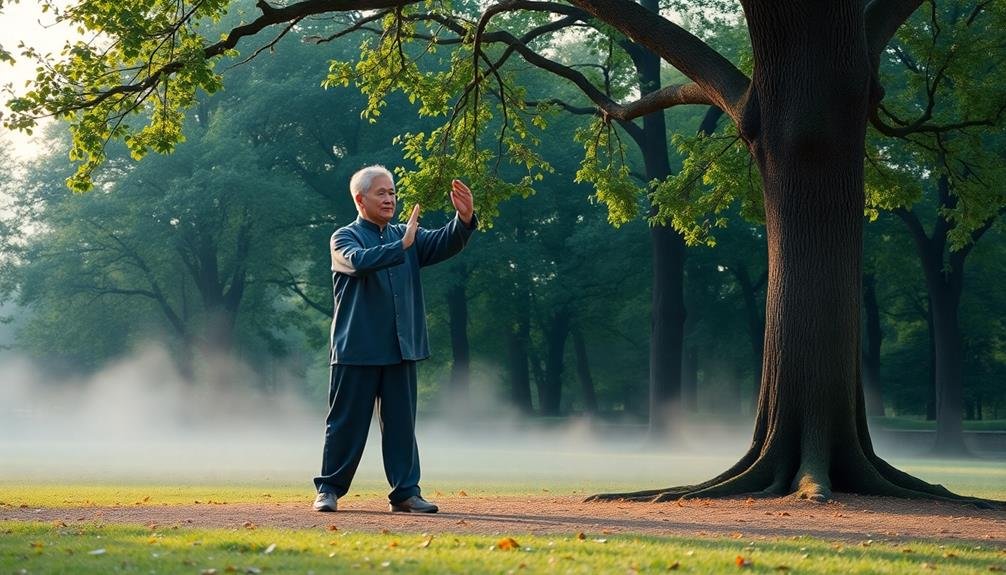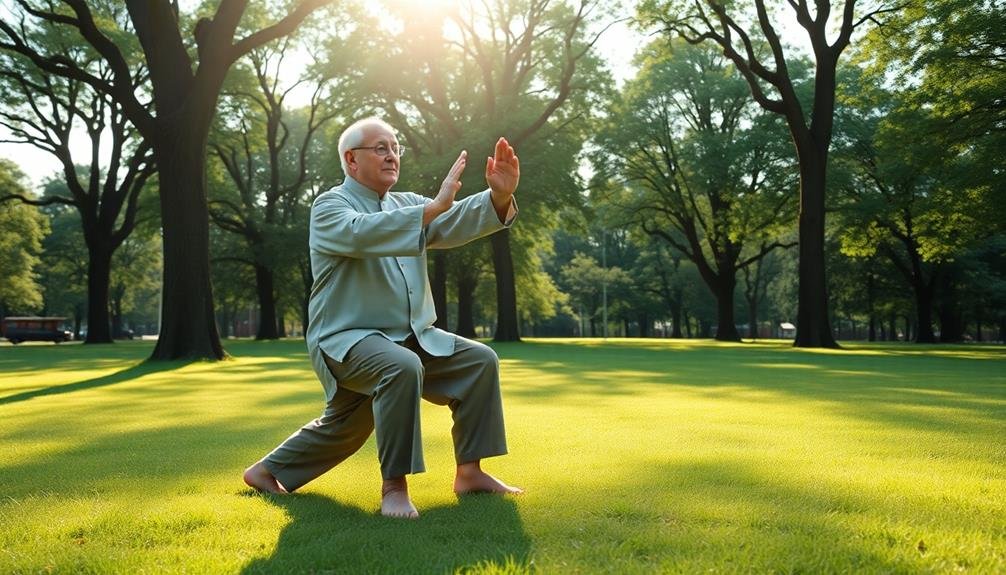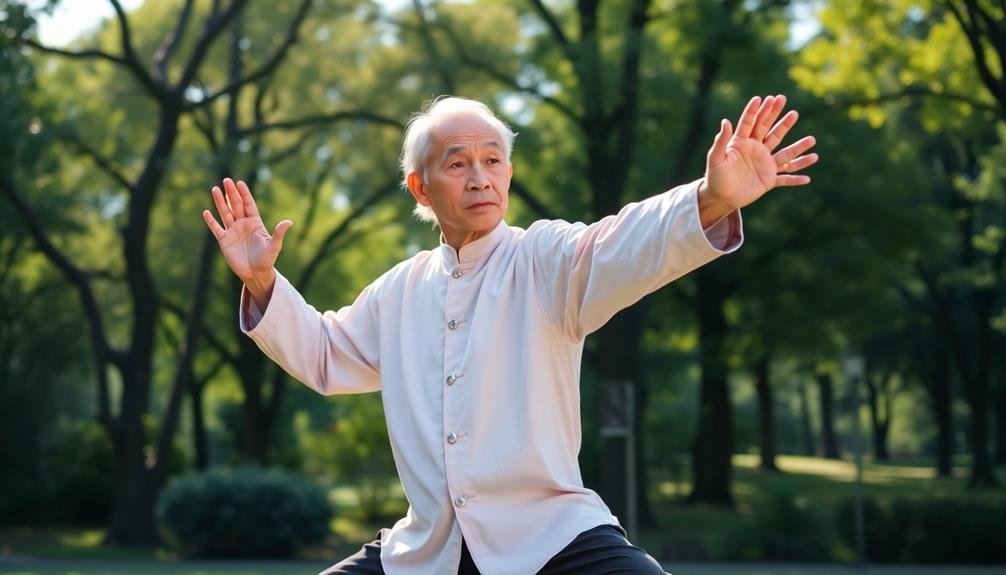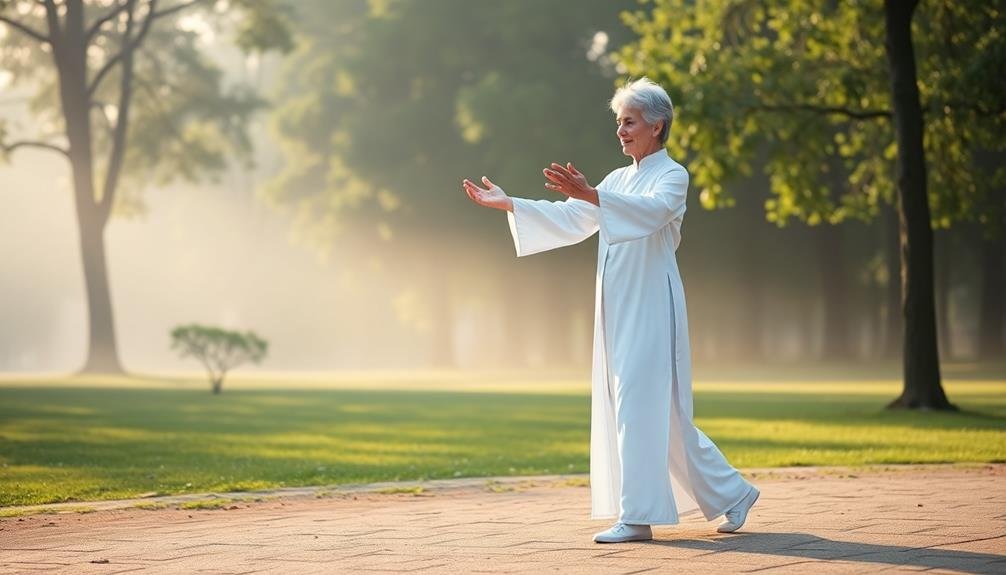Tai Chi offers several grounding moves to calm your anxious mind. The "Wave Hands Like Clouds" technique mimics gentle cloud movements, promoting tranquility and present-moment awareness. "Single Whip" engages your entire body in flowing motions, enhancing stability and encouraging deep breathing. The "Brush Knee Twist Step" combines coordinated movements with focused breathing, helping center your thoughts. These practices activate your parasympathetic nervous system, reducing stress hormones and lowering blood pressure. By incorporating these moves into your daily routine, you'll cultivate emotional stability and inner peace. Explore these techniques further to unleash Tai Chi's full potential for anxiety relief.
Understanding Tai Chi's Calming Effects

Tai Chi's calming effects stem from its combination of gentle movements, deep breathing, and mindful focus. When you practice Tai Chi, you're engaging in a form of moving meditation that helps quiet your mind and relax your body. The slow, flowing movements encourage you to be present in the moment, shifting your attention away from anxious thoughts.
As you perform Tai Chi, you'll notice an emphasis on proper breathing techniques. Deep, diaphragmatic breathing activates your parasympathetic nervous system, which helps counteract the stress response and promotes relaxation. This intentional breathing also increases oxygen flow to your brain, improving clarity and reducing tension.
The mindfulness aspect of Tai Chi trains your brain to focus on the present, rather than dwelling on past worries or future concerns. This practice can help rewire neural pathways, potentially reducing anxiety over time.
Additionally, the gentle physical activity releases endorphins, your body's natural mood boosters. Tai Chi's grounding moves, in particular, help you feel more connected to the earth and your surroundings. This connection can provide a sense of stability and security, which is especially beneficial when you're feeling anxious or overwhelmed.
The Science Behind Grounding Techniques
Grounding techniques in Tai Chi have profound effects on your brain and body.
These practices activate your parasympathetic nervous system, reducing cortisol levels and promoting a sense of calm.
As you ground yourself, you'll experience decreased heart rate, lowered blood pressure, and improved emotional regulation, all of which contribute to anxiety reduction.
Neurological Effects of Grounding
The human brain's remarkable plasticity allows it to respond positively to grounding techniques. When you practice Tai Chi grounding moves, you're activating specific neural pathways that can help reduce anxiety and promote calm. These techniques work by stimulating the parasympathetic nervous system, which counteracts the fight-or-flight response triggered by stress.
Grounding exercises influence several key areas of the brain:
| Brain Region | Function | Effect of Grounding |
|---|---|---|
| Amygdala | Processes emotions | Reduces reactivity |
| Prefrontal Cortex | Decision-making | Enhances clarity |
| Hippocampus | Memory formation | Improves focus |
| Insula | Body awareness | Increases mindfulness |
As you engage in Tai Chi grounding moves, you're fundamentally rewiring your brain to better manage stress and anxiety. The slow, deliberate movements and focused breathing activate the default mode network, which is associated with introspection and self-awareness. This neurological shift can lead to improved emotional regulation, decreased rumination, and a greater sense of overall well-being. By consistently practicing these techniques, you're building neural pathways that support a calmer, more centered state of mind.
Physiological Stress Reduction Mechanisms
Beyond the neurological effects, grounding techniques in Tai Chi have profound physiological impacts on your body's stress response systems. When you practice grounding moves, you activate your parasympathetic nervous system, which counters the fight-or-flight response triggered by anxiety. This shift promotes relaxation and reduces cortisol levels, the primary stress hormone.
Tai Chi's slow, deliberate movements and deep breathing patterns also lower your heart rate and blood pressure. As you focus on your body's connection to the ground, you'll notice improved balance and stability, which can alleviate physical tension associated with anxiety.
The rhythmic nature of Tai Chi exercises encourages diaphragmatic breathing, increasing oxygen flow to your brain and muscles.
Moreover, grounding techniques stimulate pressure points in your feet, activating the body's natural pain-relief mechanisms. This process releases endorphins, your body's feel-good chemicals, further reducing stress and promoting a sense of well-being.
The combination of mindful movement and breath awareness in Tai Chi grounding practices also enhances body awareness, helping you recognize and address physical manifestations of anxiety more effectively.
Rooting: Connecting With Earth's Energy

Rooting, a fundamental concept in Tai Chi, involves establishing a strong connection with the earth's energy. As you practice rooting exercises, you'll feel a sense of stability and grounding that can help calm anxious thoughts. Imagine drawing energy up from the earth through your feet, anchoring yourself firmly in the present moment.
To practice rooting, start with the "Wu Chi" stance. Stand with your feet shoulder-width apart, knees slightly bent, and arms relaxed at your sides. Focus on your breath and visualize roots extending from your feet into the ground. As you breathe, feel the earth's energy flowing up through these roots into your body.
Here's a simple rooting progression to try:
| Step | Duration | Focus |
|---|---|---|
| Wu Chi stance | 2-3 minutes | Breathe deeply |
| Shift weight | 1-2 minutes | Feel foot connection |
| Gentle sway | 1-2 minutes | Maintain root |
As you progress through these steps, you'll notice a growing sense of stability and calm. Regular practice of rooting exercises can help you develop a stronger connection to the earth and reduce anxiety in your daily life.
Wave Hands Like Clouds Move
One of the most calming Tai Chi movements, "Wave Hands Like Clouds," mimics the gentle flow of clouds across the sky. This graceful move helps you cultivate a sense of tranquility and release anxiety.
To perform it, stand with your feet shoulder-width apart and knees slightly bent. Begin by raising your hands to chest height, palms facing each other.
As you shift your weight to your left foot, move your right hand across your body to the left, palm facing down. Simultaneously, bring your left hand up and around, palm facing up. Continue this flowing motion, alternating sides as if you're gently parting clouds. Breathe deeply and synchronize your breath with the movement.
The repetitive nature of this exercise encourages a meditative state, allowing your mind to quiet and your body to relax.
As you practice, imagine your worries dissolving like mist. Focus on the sensation of your hands moving through the air, grounding yourself in the present moment. This mindful awareness can greatly reduce anxiety and promote a sense of calm and balance in your daily life.
Single Whip for Mental Balance

How can a single movement bring mental equilibrium? The Single Whip, a fundamental Tai Chi move, offers a powerful tool for calming anxious minds and restoring balance. As you perform this technique, you'll engage your entire body in a flowing, deliberate motion that encourages focus and mindfulness.
To execute the Single Whip, start with your feet shoulder-width apart. Shift your weight to your left foot as you raise your right arm, palm facing outward. Simultaneously, extend your left arm to the side, fingers pointing down. Rotate your torso to the right, allowing your gaze to follow your right hand. As you complete the movement, your body will form a T-shape.
The Single Whip helps ground you by connecting your upper and lower body through a controlled, graceful action. It encourages deep breathing and promotes a sense of stability.
As you practice this move, you'll find your mind quieting and your thoughts becoming more centered. The slow, intentional nature of the Single Whip allows you to release tension and cultivate a sense of inner calm, making it an excellent technique for managing anxiety.
Brush Knee Twist Step Practice
Let's explore the Brush Knee Twist Step, a powerful Tai Chi move for grounding and anxiety relief.
You'll learn how to execute this technique correctly, understand its calming benefits, and identify common pitfalls to avoid.
Execution of the Move
To perform the Brush Knee Twist Step, begin by standing with your feet shoulder-width apart and your arms relaxed at your sides. Shift your weight to your left foot and step out with your right foot, turning it slightly outward. As you do this, raise your left hand to chest height, palm facing down, while your right hand moves down and back.
Now, transfer your weight to your right foot as you "brush" your left hand past your left knee. Simultaneously, bring your right hand forward in a circular motion, ending with your palm facing outward at chest height. Your left hand should now be behind your hip.
Here's a breakdown of the movement sequence:
| Step | Left Hand | Right Hand | Body Weight |
|---|---|---|---|
| 1 | Chest high | Down and back | Left foot |
| 2 | Brushing knee | Circular forward | Shifting right |
| 3 | Behind hip | Palm out, chest high | Right foot |
As you practice, focus on maintaining a smooth, continuous flow. Keep your movements slow and deliberate, coordinating your breath with each step. This practice helps ground you in the present moment, redirecting anxious thoughts to the physical sensations of the movement.
Benefits for Anxiety Relief
The Brush Knee Twist Step offers three key benefits for anxiety relief.
First, it promotes mindfulness by requiring your full attention to execute the move correctly. As you focus on your body's movements and breath, you'll find your racing thoughts slowing down, allowing you to stay present in the moment.
Second, this move encourages deep, rhythmic breathing. As you coordinate your breath with each step and arm movement, you'll naturally engage in diaphragmatic breathing. This type of breathing activates your body's relaxation response, reducing stress hormones and calming your nervous system.
Lastly, the Brush Knee Twist Step improves your physical balance and stability. As you practice, you'll strengthen your leg muscles and core, enhancing your overall sense of groundedness.
This physical stability often translates to emotional stability, helping you feel more centered and less anxious in your daily life.
Common Mistakes to Avoid
While practicing the Brush Knee Twist Step, several common mistakes can hinder your progress and reduce the move's effectiveness. First, you might rush through the movement, losing the deliberate, flowing quality that's essential for anxiety relief. Remember to slow down and focus on each part of the motion.
Another mistake is tensing your muscles, particularly in your shoulders and arms. This tension contradicts the relaxed state you're aiming for. Keep your movements soft and fluid, allowing energy to flow freely through your body.
You might also forget to coordinate your breathing with the movement. Breathe in as you prepare to brush your knee, and exhale as you complete the twist step. This synchronization enhances the calming effect of the practice.
Incorrect weight distribution is another common error. Verify you're shifting your weight properly between your feet as you move. This helps maintain balance and promotes a sense of groundedness.
Lastly, don't neglect your posture. Keep your spine straight and your head aligned with your body. Proper alignment allows for better energy flow and maximizes the anxiety-reducing benefits of the Brush Knee Twist Step.
Implementing Tai Chi in Daily Life

Consistency is key when implementing Tai Chi into your daily routine. Start by setting aside 10-15 minutes each day for practice, preferably at the same time. You'll find it easier to stick to your routine if you integrate Tai Chi into existing habits, like practicing right after waking up or before bedtime.
Create a dedicated space for your Tai Chi practice, free from distractions. This can be indoors or outdoors, depending on your preference and available space. Keep it simple and clutter-free to maintain focus during your sessions.
| Time of Day | Tai Chi Practice | Duration |
|---|---|---|
| Morning | Standing Meditation | 5 mins |
| Afternoon | Flowing Movements | 10 mins |
| Evening | Seated Breathing | 5 mins |
As you progress, gradually increase the duration and complexity of your practice. Don't forget to listen to your body and adjust accordingly. Remember, Tai Chi is about cultivating mindfulness and inner peace, so approach your practice with patience and compassion for yourself. By consistently incorporating these grounding moves into your daily life, you'll develop a powerful tool for managing anxiety and promoting overall well-being.
Frequently Asked Questions
Can Tai Chi Be Practiced by People With Physical Limitations or Disabilities?
Yes, you can practice Tai Chi with physical limitations or disabilities. Many instructors adapt moves for individual needs. You'll find modified forms, seated versions, and gentle routines that accommodate various mobility levels and health conditions.
How Long Does It Take to See Anxiety-Reducing Effects From Tai Chi?
You'll likely notice anxiety-reducing effects from tai chi within a few weeks of regular practice. However, everyone's experience differs. You may feel calmer after your first session, but consistent practice yields the best long-term results.
Are There Any Age Restrictions for Practicing Tai Chi Grounding Moves?
You'll find no strict age restrictions for tai chi grounding moves. They're safe for most people, from children to seniors. However, if you have health concerns, it's best to consult your doctor before starting any new exercise routine.
Can Tai Chi Grounding Techniques Be Combined With Other Forms of Meditation?
You can absolutely combine Tai Chi grounding techniques with other meditation forms. They'll complement practices like mindfulness, breath work, or visualization. You'll find that integrating these methods enhances your overall meditation experience and deepens your sense of calm.
What Type of Clothing or Footwear Is Recommended for Tai Chi Practice?
You'll want to wear loose, comfortable clothing that allows easy movement. Opt for breathable fabrics like cotton. For footwear, choose flat, flexible shoes with thin soles or practice barefoot for better ground connection.
In Summary
You've now learned several key Tai Chi grounding moves to calm your anxious mind. Remember, consistency is essential. Try to incorporate these practices into your daily routine. Even a few minutes each day can make a significant difference. As you continue to practice, you'll likely notice improvements in your mental balance and overall well-being. Don't be discouraged if it takes time; Tai Chi is a journey. Stay patient and keep rooting yourself in these calming techniques.





Leave a Reply